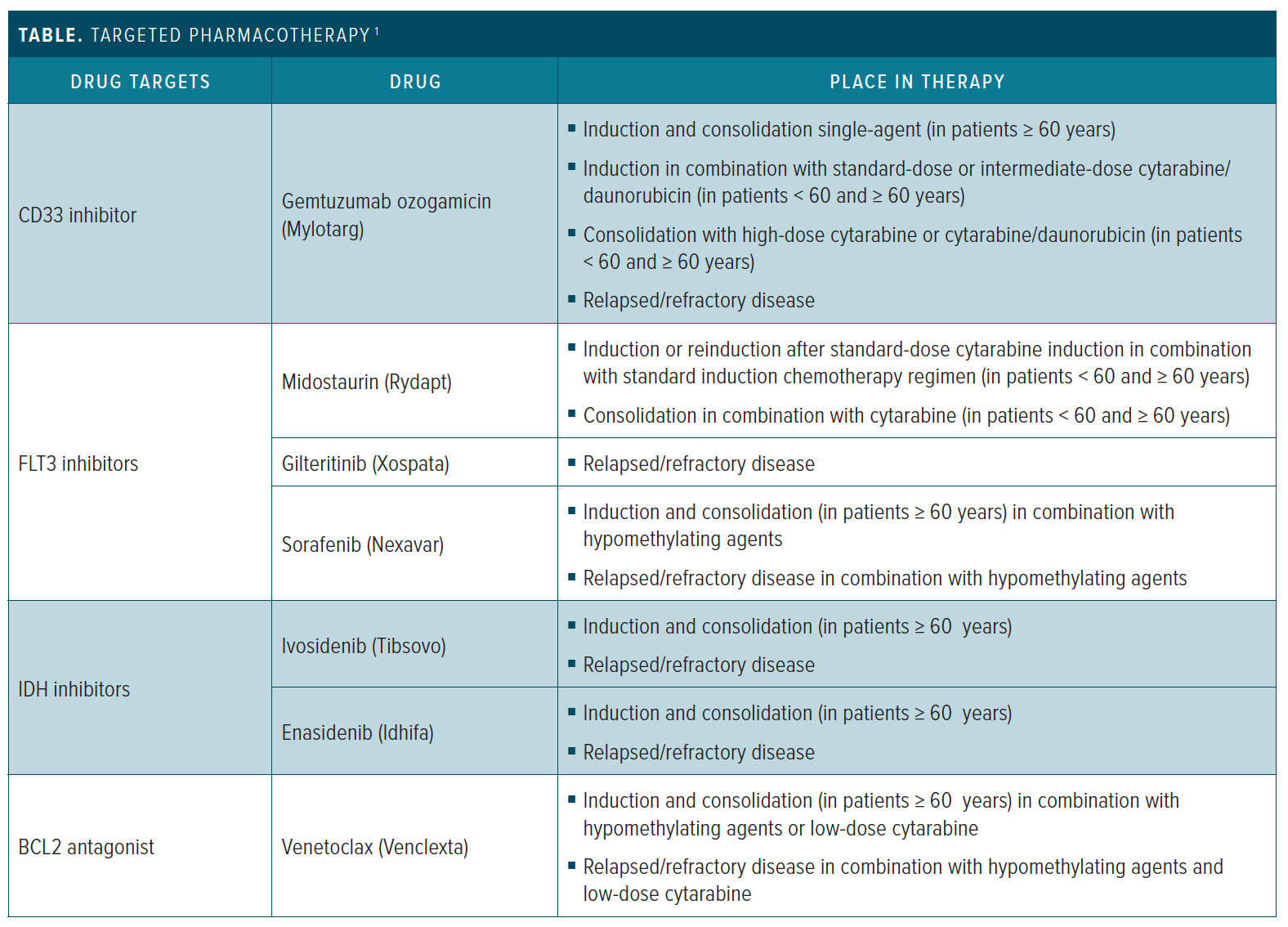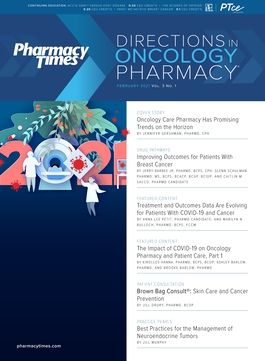Publication
Article
Pharmacy Practice in Focus: Oncology
Utilizing Pharmacogenomics Information to Guide AML Treatment
There are specific treatment options patients may qualify for depending on the cytogenetic or molecular abnormality detected.
Pharmacogenomic testing plays a large role in selecting appropriate therapy for the treatment of acute myeloid leukemia (AML), a hematologic malignancy characterized by clonal expansion of myeloid hematopoietic precursors in the bone marrow and peripheral blood.1 There are specific treatment options patients may qualify for depending on the cytogenetic or molecular abnormality detected.
AML accounts for about 80% of acute leukemias in adults. This cancer is most common in adults and is more common in men than women. The 5-year relative survival rate is about 25% for patients with AML 20 years and older, and less than 5% in those patients older than 65 years.2
Pharmacists can actively participate with the patient’s health care team in treatment selection using the patient’s genetic testing to optimize therapy, and help provide the patient’s access to the medication.
Pharmacogenomics can also be used to improve medication-related outcomes in all health care settings. Pharmacogenomic testing can reduce suboptimal clinical outcomes, decrease cost of treatment and treatment length, increase medication adherence, and improve patient safety.3
Identifying Genetic Mutations and Cancer Risks
Somatic mutations, also known as acquired mutations, are genetic alterations occurring after birth and are the most common causes of cancers. Somatic mutations are 1 of 2 main categories of mutations, with the other being germline mutations, which occur within the sperm or ovum, and can be passed from parent to offspring. Traditionally, pharmacogenomics has focused on germline mutations, but in oncology, somatic mutations determined through genetic testing serve as therapeutic targets for treating cancer.4
Both molecular genetics and cytogenetics pertain to chromosomes and genes. Molecular genetics refers to the study of structure and function of genes in a chromosome on a molecular level. Cytogenetics, which analyzes an individual’s chromosomes for numerical and structural abnormalities, is responsible for determining the patient’s cancer risk category and drives treatment selections. The mutations identified through testing drive specific treatment selections.
Selecting Appropriate Therapies
Pharmacists’ expertise can help evaluate molecular and cytogenetic analyses and actionable gene mutations for appropriateness of therapy. Induction therapy for AML is initially based on age, history of prior myelodysplasia or cytotoxic therapy, performance status, and cytogenetics.1
The National Comprehensive Cancer Network AML Guideline provides different induction regimen recommendations for patients younger than 60 years and those greater than 60 years. Older adults with AML have a poorer prognosis because of several factors, including a higher prevalence of unfavorable cytogenetics, a higher incidence of multidrug resistance, and an increased frequency of comorbid medical conditions that can negatively impact the patient’s ability to tolerate therapy. Treatment for patients older than 60 years is based on performance status and whether the patient has favorable or unfavorable cytogenetics.1
Standard induction regimens for patients younger than 60 years with AML generally include 1 or 2 cycles of cytarabine plus an anthracycline.1 Recent studies have added targeted therapies based on cytogenetics and molecular abnormalities to the standard induction regimen. In AML, genetic markers can be classified as having a favorable, intermediate, or poor prognosis. For example, translocation of portions of chromosome 8 and 28, t(8;21), is associated with a favorable prognosis, whereas translocation of portions of chromosome 9 and 22, t(9;22), is associated with a poor prognosis.1 Additionally, molecular abnormalities such as NPM1 without FLT3-ITD mutation is considered favorable, but the TP53 mutation is associated with poor disease outcomes.
Using the patient’s genetic testing, targeted therapies can be chosen to optimize treatment response. (see Table).1 CD33 is a receptor expressed primarily on myeloid cells, and patients with CD33-positive genetics tend to have a more favorable prognosis.4 The intravenous therapy gemtuzumab ozogamicin can be administered alone (AML > 60 years) or added to cytarabine plus anthracycline induction (AML < 60 years), and as part of postremission maintenance therapy in patients with CD33-positive AML.1 Gemtuzumab ozogamicin may also be used as a single agent treatment in CD33-positive relapse/refractory (R/R) AML.

FLT3 mutations can lead to overgrowth of leukemia cells and are usually associated with an intermediate prognosis.5 Patients with mutations in the FLT3 gene may benefit from oral therapy with FLT3 inhibitors midostaurin, gilteritinib, or sorafenib. Gilteritinib and sorafenib are used in the setting of maintenance therapy or treatment for R/R AML.1 Midostaurin is indicated for induction therapy as recent data have shown improved survival in patients with FLT3- mutated AML when midostaurin was added to the standard induction chemotherapy regimen. Midostaurin may also be used as consolidation therapy in combination with cytarabine.
Another mutation that can be targeted with specific drug therapy is isocitrate dehydrogenase (IDH). Mutations in the metabolic enzymes IDH1 or IDH2 can lead to increased cancer growth by blocking cell differentiation and increasing leukemic cell production.5
Ivosidenib and enasidenib are both IDH inhibitors and target IDH1 and IDH2, respectively. These are viable options for initial treatment (induction and postinduction therapy) in patients greater than 60 years or those with R/R AML with either IDH1 or IDH2 mutations.1 Overactivation of B-cell lymphoma 2 (BCL2) promotes leukemic cell survival and chemoresistance through antiapoptotic activities.5 The oral medication venetoclax targets BCL2 and is used in patients greater than 60 years with unfavorable cytogenetics.1 Venetoclax can be used as initial treatment in combination with hypomethylating agents or low-dose cytarabine or in the consolidation or R/R setting.
Assisting Patients as Part of a Care Team
Pharmacists can have a large impact on care for patients with AML by assisting with therapy selection. Pharmacists can use their clinical knowledge when multiple treatment options exist to recommend the best regimen for the patient based on drug interactions, comorbidities, toxicity profile, and other pertinent factors. Pharmacists should verify that the patient has the right cytogenetic and/or mutation to qualify for their prescribed drug based on evidence and guidelines. When a patient requires a targeted therapy that is not on the formulary, pharmacists can help by utilizing patient assistance programs and coordinating care with a specialty pharmacy that may provide the drug.6
In addition to helping select appropriate therapy for patients based on their genetic testing, pharmacists can improve access to these drugs at their institutions through their involvement with the Pharmacy and Therapeutics (P&T) Committee. Drug monographs presented to the P&T Committee are usually solely based on safety, efficacy, and acquisition cost.7 Because of the high cost of oncology drugs, pharmacists can have a significant role with the P&T Committee by taking into account other factors such as how best to utilize drugs to provide the most benefit to patients.
Pharmacists can use evidence-based medicine to help guide the formulary and clinical pathway development. Pharmacists can also play a role on the health care team by developing a pharmacogenomic-specific clinical decision support in electronic health record systems to guide prescribers to appropriate medications and doses depending on the patient’s genetics.8
KATELYN YAMARTINO, PHARMD, is a PGY-1 resident at UConn John Dempsey Hospital in Farmington, Connecticut.LISA HOLLE, PHARMD, BCOP, FHOPA, FISOPP, is an associate clinical professor at the University of Connecticut School of Pharmacy and the UConn Health Carole and Ray Neag Comprehensive Cancer Center.
REFERENCES
- NCCN. Clinical Practice Guidelines in Oncology. Acute myeloid leukemia, version 2.2021. Accessed November 12, 2020. https://www.nccn.org/professionals/physician_gls/pdf/aml.pdf
- Leukemia—acute myeloid-AML: statistics. Cancer.net. Accessed January 22, 2021. https://www.cancer.net/cancer-types/leukemia-acute-myeloid-aml/statistics
- ASHP statement on the pharmacist’s role in clinical pharmacogenomics, Am J Health Syst Pharm. 2015;72(7):579-581. doi:10.2146/sp150003
- Moarii M, Papaemmanuil E; Classification and risk assessment in AML: integrating cytogenetics and molecular profiling. Hematology Am Soc Hematol Educ Program. 2017;2017(1):37—44. doi:10.1182/asheducation-2017.1.37
- Perl AE. The role of targeted therapy in the management of patients with AML. Hematology Am Soc Hematol Educ Program. 2017;2017(1):54-65. doi:10.1182/ asheducation-2017.1.54
- Considerations in the treatment of acute myeloid leukemia. Pharmacy Times®. April 28, 2020. Accessed January 14, 2021. https://www. pharmacytimes.com/publications/directions-in-pharmacy/2020/april2020/ considerations-in-the-treatment-of-acute-myeloid-leukemia
- Leber MB. Formulary considerations: the past, present, and future. Am J Manag Care. 2017;23(12 Spec No.):SP490-SP491.
- Raheem F, Kim P, Grove M, Kiel PJ. Precision genomic practice in oncology: pharmacist role and experience in an ambulatory care clinic. Pharmacy (Basel). 2020;8(1):32. doi:10.3390/pharmacy8010032







